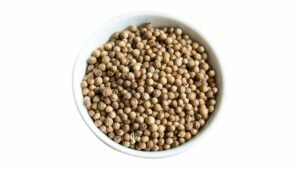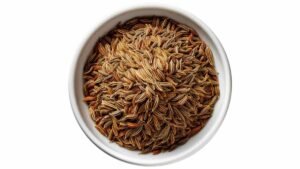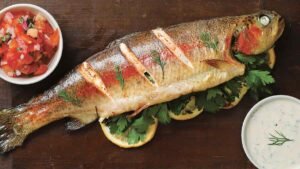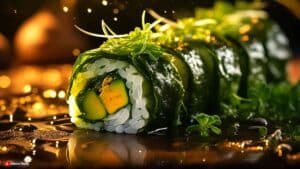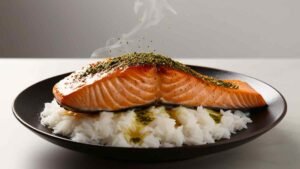Garlic is a bulbous perennial herb belonging to the onion family scientific name Allium sativum the flavor profile is Sulphours, Sweet, and Pungent. Cultivated in Central Asia, China, South Korea, Pakistan, India, Russia, and the USA. it grows to a height of 0.6m (2ft). Bulbs are ready to harvest 5–9 months after planting. Blub skins could be Yellow, white, Mauve, and pink. The bulbs are harvested when about half of the leaves have turned yellow.
After Harvest bulbs are stored in a cool and shady place for 10 to 20 days so Galic lose about one-fifth of their water content. Bulbs consist of 24 segments called cloves. Garlic is sold fresh as powder, flakes, granules, paste, juice, and extract.
Garlic can be cooked whole for a sweet and mellow effect or sliced to release a stronger flavor. However, it should not be cooked for long as it loses flavor and nutritional value during cooking. It burns easily, which affects the taste drastically. Add at the end of cooking to avoid ruining your dish.
Types of Garlic
Common Garlic(Allium sativum)
Common garlic (Allium sativum) is, in general, the longest-lived type of garlic. Thus, a type of common garlic called silverskin is commonly found in grocery stores because of its long shelf life and strong flavor. Although common garlic is often called soft neck garlic, the outer skin is usually much thicker, one of the main reasons it can be stored for longer periods. One of the easiest storage methods involves tying the stems together. Common garlic is often sold this way, but breading your garlic is much easier and more aesthetically pleasing.
Hardneck Garlic (Allium sativum var. ophioscorodon)
Hardneck garlic (Allium sativum var. ophioscorodon) is a variation that grows, as the name implies, with a thick neck but surprisingly thin skin around the bulb. Depending on growing conditions, these bulbs can produce colors anywhere from deep purple to white.
Elephant garlic (Allium ampeloprasum)
Elephant garlic (Allium ampeloprasum) is a recently named variation (1941) that is leek, although it resembles a large bulb of garlic. Despite their size, cloves are very mild and have a mild flavor. Accordingly, elephant garlic has fewer health benefits than common and hardneck garlic but offers more in quantity.
History
Garlic is one of the oldest known horticultural crops. In the Old World, Egyptian and Indian cultures referred to garlic 5000 years ago. There is clear historical evidence of its use by the Babylonians 4500 years ago and the Chinese 2000 years ago. Some texts suggest garlic was cultivated in China as far back as 4000 years ago.
Pairings
Vegetables
artichoke, asparagus, avocado, carrots, celery, eggplant, mushrooms, onions, peas, peppers, potatoes, tomatoes, zucchini
Proteins
beans, beef, chicken, cheeses, eggs, fish and seafood, sausage
Seasonings
basil, bay leaf, cayenne, cumin, ginger, honey, lemon juice, oregano, parsley, red pepper flakes, rosemary, soy sauce, thyme, Worcestershire sauce
Culinary Usage
Garlic is used in fish recipes salads, soups, sauces, dressings, marinades, stir-fries, pasta, pizzas, and roasts. Garlic paste is the base ingredient for the fish recipes and is used to make a spice paste to apply to fish. It helps to reduce the fishy smell and extracts water from fish. garlic paste is used in the fish gravy recipe also. Without garlic my fish recipes are incomplete.
In the early days of my fish recipe journey, I didn’t use garlic. But as soon as I came to know its usefulness, I started using it. Now I make garlic a must in every fish recipe. This keeps the spices from sticking to the fish and also reduces the smell of the fish.
Cooking with Garlic
Preparation
When it comes to cooking with garlic, there are many methods and traditions. Most recipes call for your garlic cloves to be crushed, chopped, minced, or roasted. Here’s how to prepare each type.
Crushed Garlic
Break a clove from the bulb, place a large knife over it, and press down. With enough pressure, it will give way and break into a couple of pieces. Once you remove the knife, the garlic and skin will separate. Discard the skin.
As mentioned, crushing garlic releases sulfides, which help lower blood pressure, and allicin, which has antifungal and antibiotic properties.
Chopped Garlic
Use the steps above to crush the garlic cloves, but keep chopping them with your knife. Once your cloves have reached the consistency you’re looking for, add a dash of salt to soak up the juices. However, if you’re watching your sodium intake, you may need to sacrifice those juices or consider mincing your garlic with a garlic press instead of using salt.
Allicin is also released during cutting due to the reaction between alliin (an amino acid) and allinase (an enzyme).
Minced Garlic
By far the easiest way to mince your garlic is with a garlic press. The press is fairly easy to use and you can often find a sturdy one fairly cheaply that will last for many years. Garlic presses have the added benefit of holding the skin in the press itself. This allows you to add one minced clove directly to your recipes at a time – no cutting board involved.
However, if you’d prefer not to buy a garlic press, minced garlic involves the same process as minced garlic, this time adding kosher salt and resharpening the flat side of the knife after chopping. Press down on the minced garlic and the salt will do all the work for you.
This is the healthiest way to enjoy your garlic. Effectively chopping your garlic means you can’t chop it any further, which also means you’ve released the maximum amount of allicin. However, you should be especially careful when using this method if you’ve chosen to mince your garlic with a grain of salt because the increased sodium intake can negate the effects of your newly produced allicin.
Roasted Garlic
When roasting garlic, start by cutting off the top of the bulb, making sure each clove is exposed. If cooking just one bulb, place in the center enough aluminum foil to wrap the entire bulb. If cooking more than one bulb, one option is to spread them out on a baking tray lined with aluminum foil. Drizzle with olive oil and season with salt and pepper.
Seal your aluminum garlic “pouch” and bake at 400 °F for 40 minutes or until the cloves are soft to the touch. Another option is to place the topless bulbs upside down in a muffin tray with olive oil on the bottom. Cover the bulbs in aluminum foil and use the same at the same time. Allow to cool before serving.
Roasting your garlic gets rid of all of its strong and pungent flavors, leaving it soft, sweet, and a nutty paste-like substance. You can use your roasted garlic in recipes or serve as part of an appetizer tray. It can be served on its own as a spread with French bread or you can empty 4-5 cloves into a serving bowl with olive oil, crushed red pepper flakes, and black pepper for dipping.
How to Roast Garlic Like Pro
A damaged garlic clove releases chemicals that react together to produce allicin, the pungent compound we most associate with a “garlic” flavor. Chopping, crushing, and pureeing gradually produce larger amounts of allicin.
- Leave for 60 seconds after crushing or cutting, so that the allicin levels rise.
- Unwounded cloves do not contain allicin. Cook all the way through for mild, sweet flavors.
- El aceite vegetal aporta los compuestos más fuertes, mientras que la mantequilla ayuda con los sabores más suaves.
- Avoid cooking garlic above 180°C (350°F) to prevent bitterness.
Drying and Storing
Enjoy the juicy fresh garlic whenever you want and store the remaining cloves in a zip-tight plastic bag in the fridge. Or, dry the whole crop – a process called “curing”. which helps to fully develop the flavor and extend its shelf life. Store domesticated garlic in a shaded, dry place with good air circulation, eg Under a large tree or on a covered porch, for a few weeks or until completely dry.
Make sure the garlic is protected from rain and sun. The skin should feel brittle, and The entire bulb should be dry and hard. Store garlic bulbs at cool room temperature in a dark place with good ventilation. Circulation, either in a container or uncovered inside a mesh bag on the counter.
Bulb Can keep up to two months if stored properly. The cloves will separate from the bulb. Stay fresh for ten days. Store sliced or diced garlic in an airtight container
Refrigerate and use it quickly.
Freeze whole or chopped garlic in a zip-tight freezer bag, but be aware that the flavor and Texture may vary from fresh garlic. You can also dry the minced garlic in the oven. Make garlic flakes or garlic powder: Spread minced garlic on a baking sheet and heat. For forty-eight hours at 115°F.
Store the dried garlic flakes in an airtight container Store on the kitchen counter for a few months, or freeze for up to a year. To make garlic Grind the flakes using a powder, clean coffee grinder, blender, or food processor.


